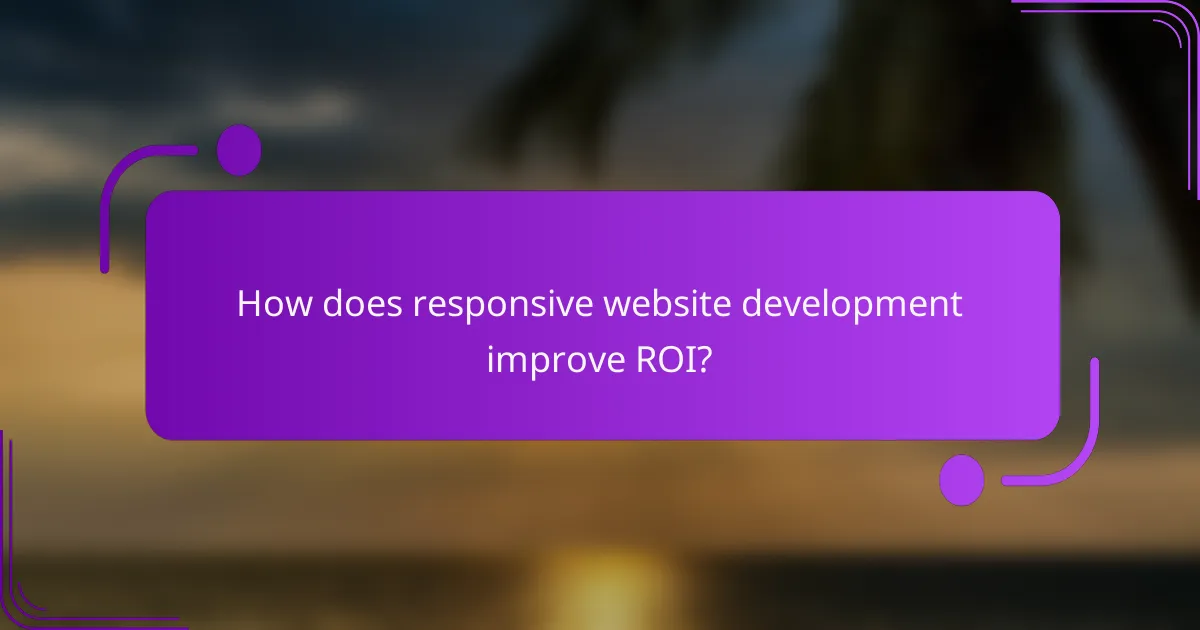Responsive website development is crucial for maximizing return on investment (ROI) by ensuring a consistent and enjoyable user experience across all devices. This approach not only enhances customer satisfaction and retention but also drives increased traffic and revenue. Evaluating the costs and financial returns associated with responsive design helps businesses understand the true value of their online presence.

How does responsive website development improve ROI?
Responsive website development enhances ROI by creating a seamless user experience across devices, which leads to increased customer satisfaction and retention. By optimizing websites for various screen sizes, businesses can attract and engage more visitors, ultimately driving higher revenue.
Increased user engagement
Responsive design encourages users to interact with your site longer, as it provides a consistent experience whether on a smartphone, tablet, or desktop. Engaged users are more likely to explore your content, leading to a deeper connection with your brand.
To boost engagement, ensure that your website loads quickly and features intuitive navigation. Consider using interactive elements like videos or quizzes that adapt to different devices, enhancing the overall user experience.
Higher conversion rates
Responsive websites typically see higher conversion rates because they cater to users’ preferences and behaviors on their chosen devices. A well-optimized site can guide visitors through the purchasing process more effectively, reducing friction and encouraging action.
To maximize conversions, focus on clear calls-to-action (CTAs) that are easily accessible on all devices. Test different layouts and designs to find what resonates best with your audience, and make adjustments based on user feedback.
Reduced bounce rates
Responsive design can significantly lower bounce rates by providing users with a pleasant browsing experience. When visitors find what they need quickly and easily, they are less likely to leave your site immediately.
To further reduce bounce rates, ensure that your site is mobile-friendly and that content is easy to read on smaller screens. Regularly analyze user behavior to identify and address any pain points that may lead to quick exits.
Enhanced brand credibility
A responsive website reflects professionalism and attention to detail, which can enhance your brand’s credibility. Users are more likely to trust a site that functions well on any device, leading to increased loyalty and repeat visits.
To build credibility, maintain a consistent brand image across all platforms, including logos, colors, and messaging. Regularly update your content and design to keep your site looking fresh and relevant.
Improved SEO performance
Search engines favor responsive websites, which can lead to better visibility in search results. A responsive design reduces the likelihood of duplicate content issues, as all users access the same URL regardless of their device.
To enhance SEO performance, ensure your site is optimized for speed and mobile usability. Utilize tools like Google’s Mobile-Friendly Test to identify areas for improvement and stay updated on SEO best practices to maintain your rankings.

What are the costs associated with responsive website development?
The costs of responsive website development can vary significantly based on design complexity, functionality, and ongoing needs. Key expenses include design and development, maintenance, and hosting fees, all of which are essential for a successful online presence.
Design and development expenses
Design and development expenses typically encompass the initial creation of the website, including user interface and user experience design. Depending on the complexity, these costs can range from a few thousand to tens of thousands of dollars. Hiring experienced developers and designers can increase upfront costs but often leads to a more effective and user-friendly site.
When budgeting, consider whether to use a template or custom design. Templates can reduce costs significantly, while custom solutions offer more flexibility and uniqueness. Always evaluate the long-term benefits of investing in quality design against initial savings.
Ongoing maintenance costs
Ongoing maintenance costs are crucial for keeping the website functional and up-to-date. These can include regular updates, security checks, and content management, typically ranging from a few hundred to several thousand dollars annually. It’s advisable to allocate a budget for these expenses to avoid larger issues down the line.
Consider setting up a maintenance plan with your development team. This can provide predictable costs and ensure timely updates. Regular maintenance helps improve site performance and user experience, which can enhance overall ROI.
Hosting and domain fees
Hosting and domain fees are essential recurring costs associated with maintaining a responsive website. Domain registration usually costs between $10 and $50 per year, while hosting can range from $5 to $500 monthly, depending on the provider and plan. Selecting a reliable host is critical for ensuring website uptime and performance.
Evaluate different hosting options, such as shared, VPS, or dedicated hosting, based on your website’s traffic and resource needs. Investing in a reputable hosting service can prevent downtime and improve user satisfaction, which is vital for maintaining your site’s effectiveness and return on investment.

How to measure the ROI of a responsive website?
Measuring the ROI of a responsive website involves evaluating the financial returns against the costs incurred during its development and maintenance. Key metrics include user engagement, conversion rates, and cost savings achieved through improved efficiency.
Tracking user metrics
Tracking user metrics is essential for understanding how visitors interact with your responsive website. Key metrics to monitor include page views, bounce rates, and average session duration, which can provide insights into user engagement and satisfaction.
Utilize tools like Google Analytics to gather data on user behavior across different devices. This information can help identify trends and areas for improvement, ultimately enhancing the user experience and increasing ROI.
Analyzing conversion data
Analyzing conversion data reveals how effectively your responsive website turns visitors into customers. Focus on metrics such as conversion rates, average order value, and cart abandonment rates to assess performance.
Consider segmenting data by device type to identify which platforms yield the highest conversions. This analysis can guide targeted marketing efforts and website optimizations, leading to improved financial returns.
Calculating cost savings
Calculating cost savings from a responsive website involves assessing reductions in maintenance and development expenses. A single responsive site can eliminate the need for separate mobile and desktop versions, leading to lower overall costs.
Additionally, consider the potential savings from improved user experience, which can lead to higher customer retention and reduced support costs. Tracking these savings over time can provide a clearer picture of your website’s ROI.

What factors influence the investment in responsive website development?
The investment in responsive website development is influenced by multiple factors including the size and industry of the business, the demographics of the target audience, and the competitive landscape. Understanding these elements can help businesses allocate resources effectively and maximize their return on investment.
Business size and industry
Larger businesses often require more complex responsive designs due to their extensive product offerings and diverse customer base. Smaller companies might focus on simpler, cost-effective solutions that still meet essential user needs. For example, a retail chain may invest significantly in a robust mobile experience, while a local service provider might prioritize basic functionality.
Industries like e-commerce and technology typically see higher returns from responsive design investments, as user experience directly impacts sales and customer retention. In contrast, sectors such as non-profits may have different priorities, focusing on accessibility and information dissemination rather than sales.
Target audience demographics
The demographics of a target audience significantly shape the investment in responsive website development. If the primary users are younger and more tech-savvy, businesses may opt for advanced features and interactive elements. Conversely, if the audience includes older users, a more straightforward design with easy navigation might be prioritized.
Additionally, understanding the devices preferred by the target audience can guide investment decisions. For instance, if analytics show that a majority of users access the site via mobile devices, investing in a mobile-first design becomes crucial.
Competitive landscape
The level of competition within an industry can dictate how much a business should invest in responsive website development. In highly competitive markets, a superior user experience can be a key differentiator, prompting companies to allocate more resources to their web presence. For example, if competitors are offering seamless mobile experiences, a business may need to enhance its own site to remain relevant.
Conducting competitor analysis can reveal gaps in the market that a responsive site can fill. Businesses should assess not only their direct competitors but also those in adjacent industries to identify best practices and innovative features that could enhance their investment strategy.

What are the best practices for responsive website development?
Best practices for responsive website development focus on creating a seamless user experience across various devices and screen sizes. Key strategies include adopting a mobile-first design, optimizing performance, and conducting regular usability testing.
Mobile-first design approach
The mobile-first design approach prioritizes the mobile user experience before scaling up to larger screens. This means designing the website for smartphones first, ensuring essential features are accessible and functional on smaller displays.
When implementing a mobile-first strategy, consider using flexible grid layouts and responsive images that adapt to different screen sizes. This approach often results in a more streamlined design and can improve loading times, as mobile users typically have varying internet speeds.
Performance optimization techniques
Performance optimization is crucial for responsive websites to ensure fast loading times and a smooth user experience. Techniques include minimizing HTTP requests, compressing images, and leveraging browser caching.
Utilize tools like Google PageSpeed Insights to identify areas for improvement. Aim for loading times under three seconds, as users are likely to abandon sites that take longer. Regularly review and optimize your code to maintain performance as content and features evolve.
Regular usability testing
Conducting regular usability testing helps identify issues and areas for improvement in the user experience of a responsive website. This can involve user feedback sessions, A/B testing, and analyzing user behavior through analytics tools.
Focus on testing across multiple devices and screen sizes to ensure consistency and functionality. Gather insights from real users to understand their challenges and preferences, and use this data to refine your design and features continuously.

How does responsive design affect SEO in major cities?
Responsive design significantly enhances SEO by improving user experience across devices, which is crucial in major cities where mobile usage is high. Search engines prioritize mobile-friendly sites, leading to better rankings and visibility in search results.
Mobile optimization benefits
Mobile optimization is essential for engaging users effectively. In urban areas, where many people access websites via smartphones, a responsive design ensures that content is easily readable and navigable without excessive zooming or scrolling.
Additionally, responsive websites tend to load faster on mobile devices, which is a key factor in SEO rankings. A site that loads in under three seconds can reduce bounce rates significantly, keeping users on the page longer and improving overall engagement.
To maximize mobile optimization, focus on simplifying navigation, using legible fonts, and optimizing images for faster loading. Regularly testing your site on various devices can help identify issues that may hinder user experience and SEO performance.
